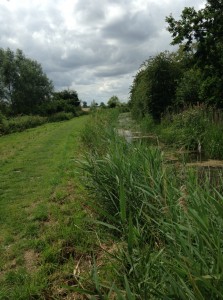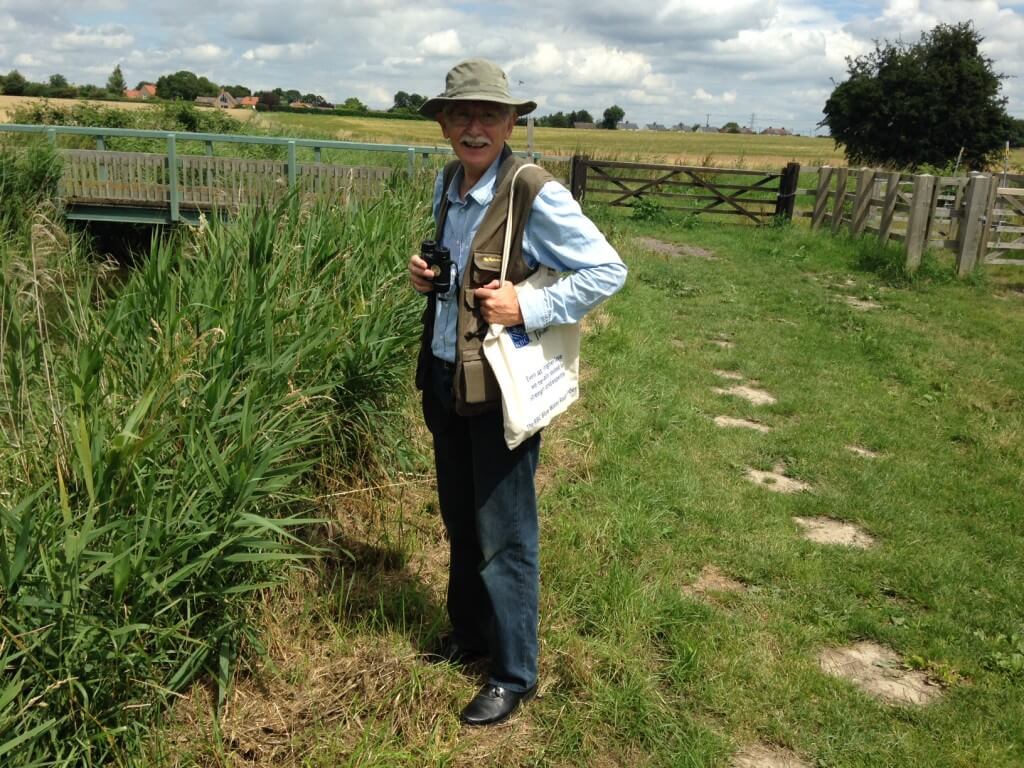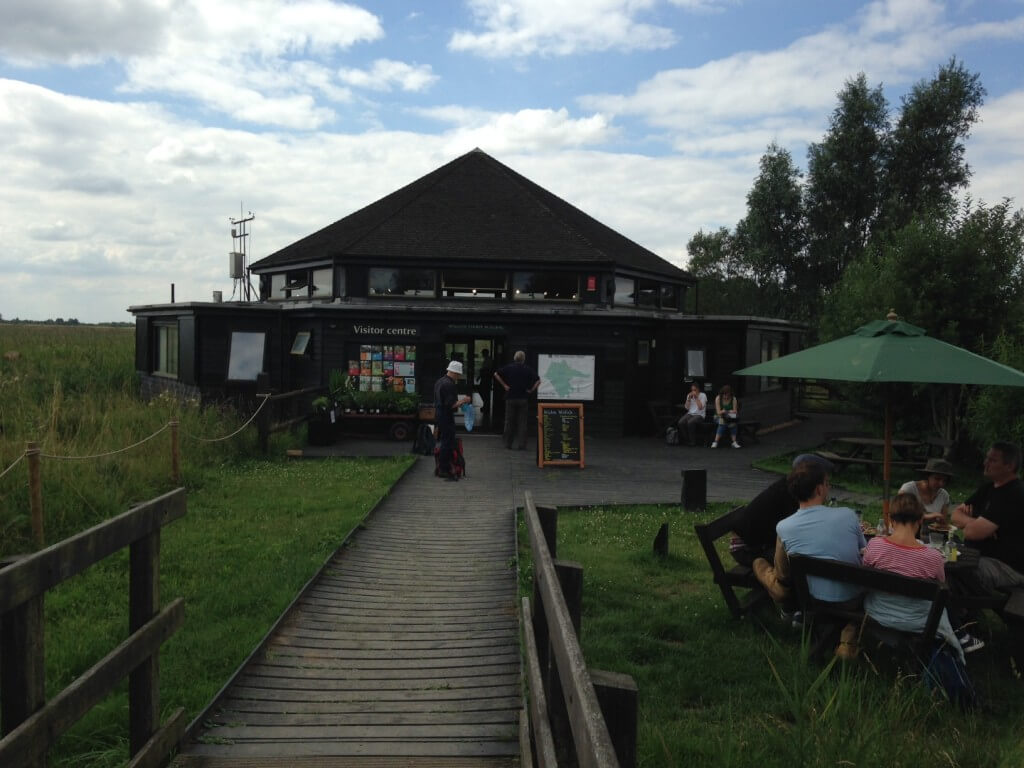If I hadn’t been with Lennox, I would have come home saying that I had had a nice toasted cheese sandwich but had seen just a Water Rail at Wicken Fen. As it was, because Len knows his dragonflies and damselflies, I could say that I’d seen about a quarter of the UK species. Most of them seemed to be damselflies whose males were blue.
 More than a week later, though, I can remember their names and quite a lot about them. They were the Blue, Varied, Azure, Emerald, Red-eyed, Small Red-eyed, Blue-tailed and (this one not at Wicken but we were keen to add it to the list) the White-legged Damselflies. There was also the Banded Demoiselle which was the only one I already knew. What a lot of small blue damselflies! I would have walked past the lot of them with barely a glance had it not been for Len’s expertise – and I know that when he reads this he will be thinking to himself that he is not an expert (but he is – and certainly compared with me).
More than a week later, though, I can remember their names and quite a lot about them. They were the Blue, Varied, Azure, Emerald, Red-eyed, Small Red-eyed, Blue-tailed and (this one not at Wicken but we were keen to add it to the list) the White-legged Damselflies. There was also the Banded Demoiselle which was the only one I already knew. What a lot of small blue damselflies! I would have walked past the lot of them with barely a glance had it not been for Len’s expertise – and I know that when he reads this he will be thinking to himself that he is not an expert (but he is – and certainly compared with me).
We also saw some larger beasts; Emperor, Four-spotted Chaser, Ruddy Darter, Black-tailed Skimmer, Migrant Hawker and Brown Hawker – making a total of 15 species out of around 55 altogether. And all we did was go for a stroll along a ‘lode’. But there were loads of Odonata.
The point is, or at least the point I took away is, that I would have noticed some dragonflies and damselflies had I been on my own but there is no chance at all that I would have realised that there were so many different species along our short walk. Despite being a naturalist of sorts, I would have been almost blind to what was going on around me. Come to think of it, Len even pointed out the Water Rail to me.
The Water Rail was very nice – quite a good view. But our conversation turned, as so many do, to the lack of Turtle Doves in our lives compared with the ‘old days’ which weren’t really that long ago. Wicken was a hot-spot for them. I remember seeing my very first Turtle Doves near here – I didn’t pay any attention to the dragonflies though.
But now I do know a few things. I know that the Common Blue Damselfly is more likely to sit out prominently in the open than the Azure or Varied and that when it is doing that I should check the shape of the black bit near the end of its abdomen and see whether it looks like a golf tee, a wine goblet or a whisky tumbler.
And I know that the Small Red-eyes that we saw would have been much less likely a few years ago before they spread north, presumably assisted by climate change. The first British records were only in 1999.
And I know that if you are to survey dragonflies, which we didn’t, but Len does, then you need 10 minutes worth of weather with ‘sharp shadows’ to get reliable counts.
July is a pretty dull month for birds – which is strange in a way. The way in which it is strange is that there must be more birds around in July than there ever were in May or June – because they have been reproducing like mad – but it often seems like the woods and fields are almost bird-less at this time of year. There is little song and lots of moulting going on. And also, the living is probably quite easy and so there is no need to rush about. So, we didn’t see many birds.
But we saw lots of Small Skippers too. Around a hundred of them sitting on patches of damp mud and perhaps sucking up water and or salts but certainly some of them were being very friendly to each other.
Thank you Len for opening my mind and my eyes to dragonflies.
PS This is the 1500th blog on this site.
[registration_form]


Congratulations on your 1500th blog. I am glad it was about insects – the most amazing, if under appreciated, group of animals.
Thanks Mark for spotlighting damselflies and dragonflies – I hope that it will encourage your many followers to take a closer look when they are next at the waterside this summer. Even if you can’t tell which is which, they are still beautiful and interesting to watch. No need to be too nerdy- just enjoy them! If you had lingered after your cup of tea, you could have added a 16th species, southern hawker!
LenC -thanks for sharing your expertise with me.
I find dragons and damsels difficult to see ( I have ‘old fashioned’ bins like you that don’t focus very close) but perhaps that’s an excuse for not trying hard enough.
As far as July bird song goes, our local Blackcap is still singing, if not quite in May mode and a couple of reeling grasshopper warblers have been reported in the last week. How unusual is that for mid July. A nightingale was singing to the end of June and I wonder if the good weather is causing some birds to considerably extend their breeding season this year?
There has been an unusual number of dragonflies strafing the garden in the last few days. I’m always surprised to see them here – given that the nearest water (scummy green ponds) is about half a mile away. Sudden increase in bumblebees and butterflies too – all the usual plus silver washed fritillaries the size of small birds amd a marbled white. Which was nice.
“… surprised …”
On the other hand: http://www.independent.co.uk/news/giant-birdeating-dragonflies-cross-the-atlantic-1198639.html
I was in London last Friday and was surprised to see a male banded demoiselle on the south bank near Blackfriars Bridge. It certainly didn’t look like typical habitat for the species!
Jonathan – I’ve never seen one there. Good record I guess. Those glimpses of wildlife in cities are rather special aren’t they?
Did you and LenC find any of the “Montrose Magpies”?
I wonder if you’d permit me to plug my Uncle’s new book in my comment. He (with many others’help) set up the Dragonfly Centre at Wicken Fen:
http://www.amazon.co.uk/gp/aw/d/1908643552?pc_redir=1405168468&robot_redir=1
Doug – you may. And Len gave me a copy of it which I will review here in due course – I’ve only dipped into it so far (I had assumed the name meant that you were some sort of relatives).
Many thanks Mark.
I hope you enjoy the book.
I did the dragonfly course at Shapwick Heath a couple of years ago; I learned 3 things:
the big ones (dragons)are relatively easy, and have a recognisable “jizz”
the little ones (damsels) are ricky, esp the blues. You really have to catch ’em, put ’em in a specimen jar and employ a magnifying glass
The hairy dragonfly, which is relatively common in Somerset, hatches early (and feeds the arriving hobbies in May), oviposits in shallow banks at the water/ shore interface; relatively rare in the steep sided somerset rhines. We have put in akm or so of shallow banks at Shapwick Moor, took a picture of a female laying a year ago (how do I add it??) Hobby food in 2 0r 3 years!!
LBJ also stands for Little Blue Job 😉